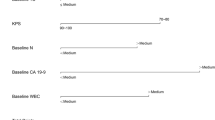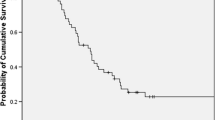Abstract
Background
We aimed to construct a prognostic model to predict survival in patients with advanced pancreatic cancer (APC) receiving palliative chemotherapy using readily available pretreatment factors.
Methods
The model was constructed using data from 306 consecutive patients with APC who received palliative chemotherapy between January 2006 and March 2013. The predictive accuracy of the model was assessed using a concordance index (c-index) and calibration curves.
Results
Among the 12 potential prognostic factors investigated, multivariate analysis identified the following six independent negative prognostic factors—performance status (PS), the presence of distant metastatic disease, the status of initially unresectable disease, carcinoembryonic antigen (CEA) level, carbohydrate antigen 19-9 (CA19-9) level, and neutrophil–lymphocyte ratio (NLR). A prognostic index (PI) based on the coefficients of these factors was constructed as follows—PI = 2 (if PS 2–3) + 1 (if distant metastatic disease) + 1 (if initially unresectable disease) + 1 (if CEA level ≥5.0 ng/ml) + 1 (if CA 19-9 level ≥1,000 U/ml) + 2 (if NLR ≥5). The patients were classified into three prognostic groups—favorable (PI 0–1, n = 73), intermediate (PI 2–3, n = 145), and poor (PI 4–8, n = 88). The median overall survival times for each prognostic group were 16.5, 12.3, and 6.2 months, respectively (P < 0.001). Bootstrapping verified the good fitness of this model for predicting 1-year survival, and the c-index was 0.658.
Conclusions
This simple prognostic model could help clinicians to estimate survival in patients with APC who receive palliative chemotherapy.



Similar content being viewed by others
References
Hidalgo M (2010) Pancreatic cancer. N Engl J Med 362(17):1605–1617
Ueno H, Okada S, Okusaka T et al (2000) Prognostic factors in patients with metastatic pancreatic adenocarcinoma receiving systemic chemotherapy. Oncology 59(4):296–301
Morizane C, Okusaka T, Morita S et al (2011) Construction and validation of a prognostic index for patients with metastatic pancreatic adenocarcinoma. Pancreas 40(3):415–421
Humphris JL, Chang DK, Johns AL et al (2012) The prognostic and predictive value of serum CA19.9 in pancreatic cancer. Ann Oncol 23(7):1713–1722
Bauer TM, El-Rayes BF, Li X et al (2013) Carbohydrate antigen 19-9 is a prognostic and predictive biomarker in patients with advanced pancreatic cancer who receive gemcitabine-containing chemotherapy: a pooled analysis of 6 prospective trials. Cancer 119(2):285–292
Stotz M, Gerger A, Eisner F et al (2013) Increased neutrophil-lymphocyte ratio is a poor prognostic factor in patients with primary operable and inoperable pancreatic cancer. Br J Cancer 109(2):416–421
Hamada T, Nakai Y, Yasunaga H et al (2014) Prognostic nomogram for nonresectable pancreatic cancer treated with gemcitabine-based chemotherapy. Br J Cancer 110(8):1943–1949
Szkandera J, Stotz M, Absenger G et al (2014) Validation of C-reactive protein levels as a prognostic indicator for survival in a large cohort of pancreatic cancer patients. Br J Cancer 110(1):183–188
Xue P, Kanai M, Mori Y et al (2014) Neutrophil-to-lymphocyte ratio for predicting palliative chemotherapy outcomes in advanced pancreatic cancer patients. Cancer Med 3(2):406–415
Xue P, Kanai M, Mori Y et al (2014) Comparative outcomes between initially unresectable and recurrent cases of advanced pancreatic cancer following palliative chemotherapy. Pancreas 43(3):411–416
Proctor MJ, McMillan DC, Morrison DS et al (2012) A derived neutrophil to lymphocyte ratio predicts survival in patients with cancer. Br J Cancer 107(4):695–699
Cho IR, Park JC, Park CH et al (2014) Pre-treatment neutrophil to lymphocyte ratio as a prognostic marker to predict chemotherapeutic response and survival outcomes in metastatic advanced gastric cancer. Gastric Cancer 17(4):703–710
Li MX, Liu XM, Zhang XF et al (2014) Prognostic role of neutrophil-to-lymphocyte ratio in colorectal cancer: a systematic review and meta-analysis. Int J Cancer 134(10):2403–2413
McNamara MG, Templeton AJ, Maganti M et al (2014) Neutrophil/lymphocyte ratio as a prognostic factor in biliary tract cancer. Eur J Cancer 50(9):1581–1589
Pinato DJ, Shiner RJ, Seckl MJ et al (2014) Prognostic performance of inflammation-based prognostic indices in primary operable non-small cell lung cancer. Br J Cancer 110(8):1930–1935
Xiao WK, Chen D, Li SQ et al (2014) Prognostic significance of neutrophil-lymphocyte ratio in hepatocellular carcinoma: a meta-analysis. BMC Cancer 14:117
Teramukai S, Ochiai K, Tada H et al (2007) PIEPOC: a new prognostic index for advanced epithelial ovarian cancer–Japan Multinational Trial Organization OC01-01. J Clin Oncol 25(22):3302–3306
Park MJ, Lee J, Hong JY et al (2009) Prognostic model to predict outcomes in nonsmall cell lung cancer patients treated with gefitinib as a salvage treatment. Cancer 115(7):1518–1530
Kanagavel D, Pokataev IA, Fedyanin MY et al (2010) A prognostic model in patients treated for metastatic gastric cancer with second-line chemotherapy. Ann Oncol 21(9):1779–1785
Halabi S, Lin CY, Kelly WK et al (2014) Updated prognostic model for predicting overall survival in first-line chemotherapy for patients with metastatic castration-resistant prostate cancer. J Clin Oncol 32(7):671–677
Burris HA 3rd, Moore MJ, Andersen J et al (1997) Improvements in survival and clinical benefit with gemcitabine as first-line therapy for patients with advanced pancreas cancer: a randomized trial. J Clin Oncol 15(6):2403–2413
Ueno H, Okusaka T, Ikeda M et al (2005) An early phase II study of S-1 in patients with metastatic pancreatic cancer. Oncology 68(2–3):171–178
Nakamura K, Yamaguchi T, Ishihara T et al (2006) Phase II trial of oral S-1 combined with gemcitabine in metastatic pancreatic cancer. Br J Cancer 94(11):1575–1579
Moore MJ, Goldstein D, Hamm J et al (2007) Erlotinib plus gemcitabine compared with gemcitabine alone in patients with advanced pancreatic cancer: a phase III trial of the National Cancer Institute of Canada clinical trials group. J Clin Oncol 25(15):1960–1966
Oken MM, Creech RH, Tormey DC et al (1982) Toxicity and response criteria of the Eastern Cooperative Oncology Group. Am J Clin Oncol 5(6):649–655
Tanaka T, Ikeda M, Okusaka T et al (2008) Prognostic factors in Japanese patients with advanced pancreatic cancer treated with single-agent gemcitabine as first-line therapy. Jpn J Clin Oncol 38(11):755–761
Papadoniou N, Kosmas C, Gennatas K et al (2008) Prognostic factors in patients with locally advanced (unresectable) or metastatic pancreatic adenocarcinoma: a retrospective analysis. Anticancer Res 28(1B):543–549
Haas M, Laubender RP, Stieber P et al (2010) Prognostic relevance of CA 19-9, CEA, CRP, and LDH kinetics in patients treated with palliative second-line therapy for advanced pancreatic cancer. Tumour Biol 31(4):351–357
Steyerberg EW (2009) Clinical Prediction Models. Springer, New York
Harrell FE, Lee KL, Mark DB (1996) Multivariable prognostic models: issues in developing models, evaluating assumptions and adequacy, and measuring and reducing errors. Stat Med 15:361–387
Harrell FE, Califf RM, Pryor DB et al (1982) Evaluating the yield of medical tests. JAMA 247:2543–2546
Okusaka T, Funakoshi A, Furuse J et al (2008) A late phase II study of S-1 for metastatic pancreatic cancer. Cancer Chemother Pharmacol 61(4):615–621
Conroy T, Desseigne F, Ychou M et al (2011) FOLFIRINOX versus gemcitabine for metastatic pancreatic cancer. N Engl J Med 364(19):1817–1825
Ueno H, Ioka T, Ikeda M et al (2013) Randomized phase III study of gemcitabine plus S-1, S-1 alone, or gemcitabine alone in patients with locally advanced and metastatic pancreatic cancer in Japan and Taiwan: GEST study. J Clin Oncol 31(13):1640–1648
Von Hoff DD, Ervin T, Arena FP et al (2013) Increased survival in pancreatic cancer with nab-paclitaxel plus gemcitabine. N Engl J Med 369(18):1691–1703
Luo G, Guo M, Liu Z et al (2015) Blood neutrophil-lymphocyte ratio predicts survival in patients with advanced pancreatic cancer treated with chemotherapy. Ann Surg Oncol 22(2):670–676
Inoue D, Ozaka M, Matsuyama M et al (2015) Prognostic value of neutrophil-lymphocyte ratio and level of C-reactive protein in a large cohort of pancreatic cancer patients: a retrospective study in a single institute in Japan. Jpn J Clin Oncol 45(1):61–66
Qi Q, Geng Y, Sun M, et al (2015) Clinical implications of systemic inflammatory response markers as independent prognostic factors for advanced pancreatic cancer. Pancreatology. [Epub ahead of print]
Shirasaka T (2009) Development history and concept of an oral anticancer agent S-1 (TS-1): its clinical usefulness and future vistas. Jpn J Clin Oncol 39(1):2–15
Conflict of interest
The authors declare that they have no conflict of interest.
Author information
Authors and Affiliations
Corresponding author
About this article
Cite this article
Kou, T., Kanai, M., Yamamoto, M. et al. Prognostic model for survival based on readily available pretreatment factors in patients with advanced pancreatic cancer receiving palliative chemotherapy. Int J Clin Oncol 21, 118–125 (2016). https://doi.org/10.1007/s10147-015-0864-x
Received:
Accepted:
Published:
Issue Date:
DOI: https://doi.org/10.1007/s10147-015-0864-x




